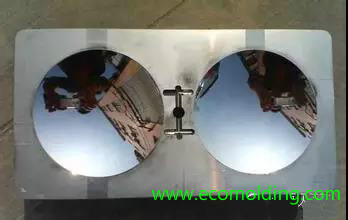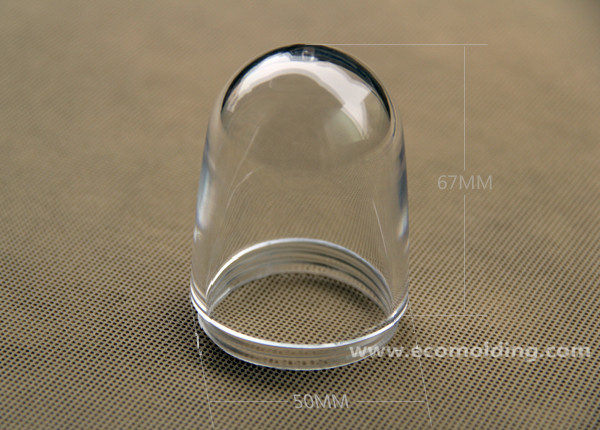
When industrial products are developing towards diversification and high quality, it is an important task to improve the quality of the molds that directly affect product quality. During mold manufacturing, smooth mirror finishing after shaping, referred to as surface grinding and polishing of a part, is an important process step to improve the quality of the mold. Understanding a proper polishing method is able to improve mold quality, as well as service life, thereby enhancing product quality.
Common Mold Polishing Methods & How They Work
1. Mechanical Polishing
Mechanical polishing is a method that removes the protruding parts on the surface of a workpiece by cutting or plastically deforming the surface of a material to obtain a smooth surface, during which oilstones, wool wheels and sandpaper, etc. are usually used by performing manual operations, and if the surface quality requirements are high, ultra-precision lapping and polishing will be adopted. Ultra-precision lapping and polishing employs a special-purpose grinding tool, which, soaked in a polishing liquid containing abrasives, is pressed against the machined surface of a workpiece to perform high-speed rotation. With this technology, the surface roughness of Ra0.008 μm is able to be achieved, which represents the best surface roughness among various polishing methods, and is usually applied to the polishing of optical lens molds. Mechanical polishing is the main method of mold polishing.
2. Chemical Polishing
Chemical polishing refers to the process in which a material is soaked in a chemical medium that allows the micro projections on the material surface to firstly dissolve before the dents, thus obtaining a smooth surface. The method can be applied to polish a workpiece with a complicated shape, and is able to concurrently work on many workpieces to achieve a high efficiency. The surface roughness able to be obtained by chemical polishing is usually Ra10 μm.
3. Electropolishing
The basic principle of electropolishing is the same as chemical polishing, which is to selectively dissolve the surface of a material to create a smooth surface. Compared with chemical polishing, it can eliminate the influence of the cathode reaction, thus producing a great effect.
4. Ultrasonic Polishing
Ultrasonic polishing is a method that uses a tool section for ultrasonic vibration to polish a brittle hard material by using an abrasive suspension. A workpiece is soaked in an abrasive suspension, and then placed in an ultrasonic field together with the suspension that grinds and polishes the surface of the workpiece by the action of ultrasonic waves. Ultrasonic machining has a small macroscopic force, so it does not cause workpiece deformation, but it is difficult to manufacture and install the tooling.
5. Fluid Polishing
Fluid polishing relies on a flowing liquid and the abrasive particles it carries to erode the surface of a workpiece for polishing purposes. Hydrodynamic grinding is driven by hydraulics, of which, the medium is mainly made of a special compound (polymeric substance) that flows at a lower pressure and is incorporated into an abrasive that may be made of silicon carbide powder.
6. Magnetic Grinding & Polishing
Magnetic grinding & polishing is the use of magnetic abrasives to form an abrasive brush under the action of a magnetic field to grind a workpiece. This method features a high processing efficiency, great quality and easy-to-control processing conditions. With suitable abrasives, the surface roughness able to be obtained through this method reaches up to Ra0.1 μm.
7. EDM-Ultrasonic Polishing
To improve the polishing speed of a workpiece with a surface roughness of Ra1.6 μm or more, the ultrasonic wave is combined with a dedicated high-frequency, narrow-pulse and high-peak value power source for compound polishing, with ultrasonic vibration and electric pulse corrosion simultaneously acting on the surface of a workpiece to rapidly reduce surface roughness, which is effective for polishing the rough surface of a mold after machining by cutting, milling, EDM and wire cutting.

Important Considerations for Plastic Mold Polishing
The mold polishing differs a lot from the surface polishing required by other industries. Technically, the polishing of a plastic mold should be referred to as mirror finishing. Not only does it impose high requirements for polishing itself, but it also has a high standard for surface flatness, smoothness and geometric precision. The standard for mirror polishing is divided into 4 levels: A0 = Ra0.008 μm, A1 = Ra0.016 μm, A3 = Ra0.032 μm, and A4 = Ra0.063 μm. Since it is difficult to accurately control the geometric precision of a part with electropolishing and fluid polishing, while the surface quality obtained through chemical polishing, ultrasonic polishing, and magnetic grinding & polishing does not meet the requirements, the mirror polishing of precision molds is dominated by mechanical polishing.
The important polishing considerations are as follows:
(1) Before you begin to machine a new cavity, first inspect the surface of the workpiece and then clean it with kerosene, so that the cutting feature of the oilstone does not malfunction due to attraction of dirt.
(2) When grinding a rough surface, the job should be carried out from the difficult part to the easy part. Especially for some dead corners that are difficult to grind, the deep bottom must be ground first, and finally the sides and the large flat surface.
(3) Some workpieces may have multiple components assembled together for grinding. It is necessary to separately grind the rough texture or EDM pattern of a single workpiece before grinding and smoothening the assembled workpiece.
(4) For workpieces with a large flat surface or a side surface, use oilstone to grind the rough lines and then use straight steel sheets for light transmission inspection, to check whether there are any unevenness or undercuts. If so, it will be difficult to release the part or the part may be damaged.
(5) To eliminate undercuts caused by mold part grinding, or respond to the situation where some contacting surfaces need to be protected, a saw blade or sandpaper can be attached to the edge to obtain an ideal protective effect.
(6) Pull back and forth to grind the flat surface of a mold, and try to keep the handle of the oilstone as horizontal as possible. Do not exceed 25°, because when the slope is too large, the force is pressed top-down, which may lead to the creation of many rough lines on the workpiece.
(7) When the surface of a workpiece is polished with copper- or bamboo-pressed sandpaper, the sandpaper should not be larger than the tool area, otherwise the parts that are not supposed to be ground will be ground.
(8) Try not to use a sander to repair the parting surface, because the parting surface polished by the wheel head is rough with uneven waves. When necessary, the wheel head must be fixed with concentric balance.
(9) The shape of the grinding tool should be close to the surface shape of the mold, so as to guarantee that the workpiece is not deformed by grinding.
Cavity polishing during mold manufacturing is a very important process step that is closely related to the quality and service life of a mold, while also determining the quality of the product. Understanding how polishing works, mastering the technological process and selecting an appropriate polishing method can improve the quality, as well as the service life of a mold, thus improving the quality of the final product.
Please feel free to contact us if you are looking for a professional injection mold manufacturer
